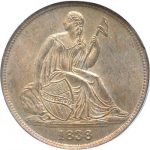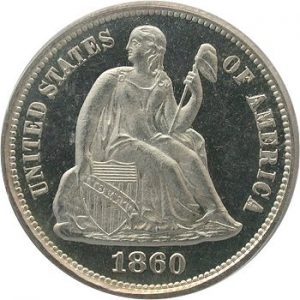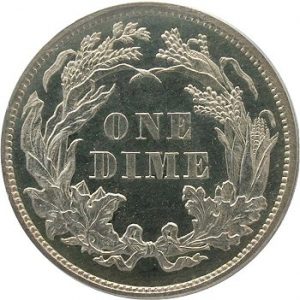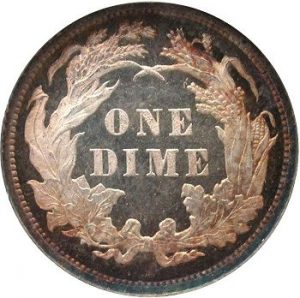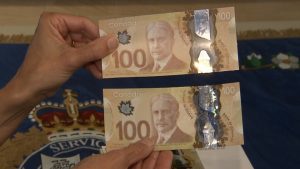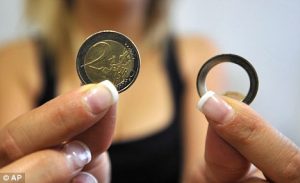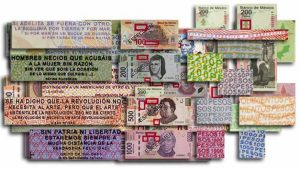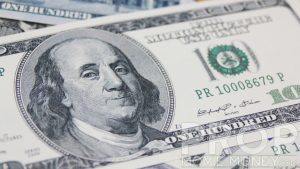About the U.S. Mint’s Silver Shortage
This is the first article of three regarding the recent problems at the U.S. Mint.
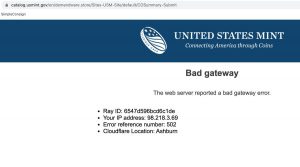 Economic analysts believe there is a silver shortage but that it is not critical. According to the supply chain reports, a sufficient supply of industrial silver for manufacturers to keep up with production. The reduction in computer chip production because of COVID-based plant shutdowns is the greatest threat to manufacturing.
Economic analysts believe there is a silver shortage but that it is not critical. According to the supply chain reports, a sufficient supply of industrial silver for manufacturers to keep up with production. The reduction in computer chip production because of COVID-based plant shutdowns is the greatest threat to manufacturing.
Jewelry and other businesses that use silver for their beauty are experiencing a slowdown but not to the extent of the computer chip industry. The industry has been able to use recycled silver fueled by people cashing in their scrap silver. One silver refiner reports that they have more work than they can process.
Although manufacturers have silver to maintain production, the U.S. Mint announced on May 28, 2021, that “The global silver shortage has driven demand for many of our bullion and numismatic products to record heights.”
On June 2, the U.S. Mint clarified their statement by saying, “In a message released Friday, May 28, we made reference to a global shortage of silver. In more precise terms, the silver shortage being experienced by the United States Mint pertains only to the supply of silver blanks among suppliers to the U.S. Mint.”
Why is the U.S. Mint different from the other industries?
The short answer is that the U.S. Mint is just another government agency subject to federal law.
The U.S. Mint is required to buy silver mined in the United States within one year of its mining (31 U.S. Code §5132(a)(2)(D)). Under this law, the U.S. Mint cannot use recycled silver or silver that the government has not purchased from the mines.
The U.S. Mint discontinued assay operations shortly after the passage of the Coinage Act of 1964. Since then, the bureau has bought the metals from other manufacturers, either sheets or already formed planchets. When the American Eagle Program started, the law required the U.S. Mint to use the silver in the Strategic and Critical Materials Stockpile. The U.S. Mint manufactured the planchets in West Point.
When the program depleted the Strategic Stockpile, Congress updated the law to require the U.S. Mint to use freshly mined silver. They found that it was more cost-effective to have a commercial vendor manufacture the planchets.
Hiring a commercial vendor to do work for the federal government is different from a business-to-business transaction. The government requires all contracts and contractors to follow the Federal Acquisition Regulations (FAR) to purchase goods and services.
For the government to contract with any company, a bidding and vetting process can last from weeks to years. The agency has to produce requirements, selection criteria and evaluate the proposals, called source selection.
Congress purposely made the process challenging to promote fairness in the bidding process and ensure the government pays a fair price. Unfortunately, the process is expensive and fraught with problems.
For the U.S. Mint, the problem is that FAR does not allow the latitude to find alternate vendors when there are supply issues.
The U.S. Mint has contracts with four vendors to make silver planchets. They have vetted the contractors, their processes and have contractual quality control measures to ensure the planchets comply with the Treasury’s legal and quality requirements. If the vendors cannot fulfill the U.S. Mint’s order, the law prevents them from looking for immediate alternatives.
According to the U.S. Mint, the suppliers of silver planchets had production slowdowns because of COVID-19 operating precautions. In addition to manufacturing issues, the mining operators also experienced slowdowns because of the same operating precautions. Every industry is experiencing supply chain interruptions.
Where the U.S. Mint could have done better was to order the planchets sooner. The U.S. Mint reported that agency attorneys refused to allow their purchasers to order planchets before the law was signed. The bill, H.R. 6192, was sent to the president on December 24, 2020. The president signed the bill into law on January 5, 2021 (Public Law No. 116-286).
When a law is signed, the White House will tell the appropriate Departments. If that does not happen, the agencies receive notice from the Government Printing Office (GPO) who publishes the laws. Like everything else, the GPO has experienced interruptions because of pandemic protocols.
According to a government attorney that works for the Inspector General’s office in a non-Treasury department, agencies have the latitude to work on anticipated laws. An example cited is that the IRS works on drafting forms and regulations based on the bills in progress to be ready for the filing season.
Although Congress did not do the U.S. Mint a favor by passing the bill on Christmas Eve, the White House did not do the U.S. Mint a favor by not letting the Treasury know they signed the bill. However, the leadership of the U.S. Mint allowed the lawyers to dictate operations. The lawyers are supposed to be advisors, not the last word.
Collecting Small Dollars: The Susie B
- The Susie B ← you are here
- The Golden Dollar
- Native American Dollars
- Presidential Dollar Series
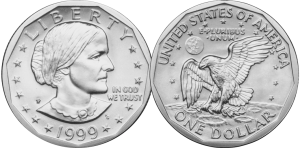 By the mid-1970s, the appeal of the large dollar had diminished when the U.S. Mint found that the Eisenhower dollar was not circulating. After conducting the study, it was decided to replace the 38 mm (1.5 inches) coin with something smaller.
By the mid-1970s, the appeal of the large dollar had diminished when the U.S. Mint found that the Eisenhower dollar was not circulating. After conducting the study, it was decided to replace the 38 mm (1.5 inches) coin with something smaller.
The U.S. Mint tried testing several different shapes and composition only to be met with opposition from the vending machine industry and their powerful lobby. Even though the U.S. Mint tried to convince congress to approve a multi-sided coin, congress made the decision to change it to a round coin with an eleven-sided inner border.
As the discussions about the coin continued, Treasury proposed a bust of Liberty with a Phrygian hat on a pole, a modern update to earlier designs designed by Frank Gasparo. However, the League of Women Voters lobbied for the inclusion of a woman on a coin. As the idea gained support in congress, chose suffragette Susan B. Anthony for that honor.
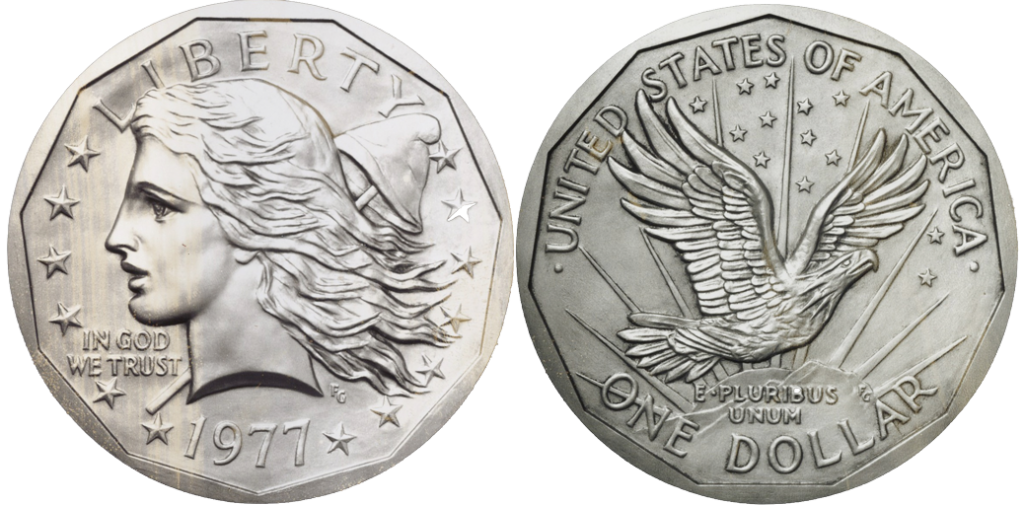
U.S. Mint Chief Engraver Frank Gasparro proposed a classic Liberty design for the new small dollar coin
When the coin was released to an excited public, the excitement disappeared when it was mistaken for a quarter. Since the coin, nicknamed the Susie B, was only 2 mm larger than the quarter, it did not help that the coin was made of the same alloy and had a reeded edge. It was even denounced by the seeing impaired community as not being distinctive enough to tell the difference tactically.
There were over 757 million coins struck in 1979, 89 million in 1980, and 9.7 million in 1981 that did not circulate well. By the end of 1981, the U.S. Mint reported that they had 520 million surplus coins. The lack of circulation gives the collector the ability to collect a nice set. Even with the 41 million dollars struck for 1999, there are 12 coins to make a complete set.
To extend the collection besides the usual date and mintmark series, a collector may add proof coins and varieties. For circulated strikes, there was an alteration in the design of the 1979 coin that is noticeable around the date on the coins struck in Philadelphia. The 1979-P Type 1 coin is called the Narrow Rim or Small Date variety where it looks like there room between the date and the rim. When looking for Type 2 Wide Rim or Near Date coin, it looks as if the date is almost touching the rim. The Type 1 coin is more plentiful and is inexpensive. The Type 2 Wide Rim coin is less plentiful but still affordable at less than $40 for a nice example.
If you add proof coins to your collection, the 1979-S and 1981-S proof coins also have two varieties based on the condition of the “S” mintmark. The 1979-S Type 1 has an “S” that is filled in, almost looking like a blob. It was later fixed to look clearer later in the year creating a Type 2 coin. The difference between the Type 1 and Type 2 1981-S proof coin is subtler. The Type 1 “S” looks the same as the one used for the 1979-S Type 2 and on 1980-S coin. The 1981-S Type 2 proof coin has a much clearer “S” than the others. When trying to assemble a complete series of Susie B Dollars, the 1981-S Type 2 proof coin is the most expensive with an average of $120 and considered the key to the series.When putting together a complete 16 coin Susan B. Anthony Dollar set, remember that the 1999 proof coin was struck in Philadelphia. It was produced for the regular proof set and in its own presentation case, both are readily available.
In the next installment, we look at the Golden Dollar.
- Coin image is a composite of images from the U.S. Mint.
- Composit image of proposed dollar design courtesy of National Numismatic Collection, National Museum of American History via Wikipedia.
- 1979 SBA Rim Variety identification image courtesy of PCGS CoinFacts
- “S” mintmark comparison image courtesy of Stuart’s Coins
A $2 Love Story
Did you know that someone made a movie about the $2 bill?
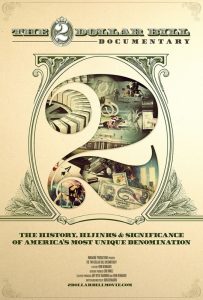 I was looking for information about early $2 notes and an Internet search discovered the page for The Two Dollar Bill Documentary.
I was looking for information about early $2 notes and an Internet search discovered the page for The Two Dollar Bill Documentary.
Basically, it is a 1 hour 43 minute documentary about the $2 bill. Written and directed by John Bennardo, who has one other film to his credits, writes on the website that he wanted to learn more about the stack of $2 bills he kept in his desk draw. A year and several interviews later, Bennardo had a documentary.
Amongst the people who appear in the documentary is Charlene Williams, Director of Manufacturing at the Bureau of Engraving and Printing facility in Fort Worth, Fred Bart, owner of Executive Currency, and Ben Cohen who is the “Ben” in Ben & Jerry’s.
I do not know how I missed this because it was the Kickstarter campaign written about in CoinWeek, and I am a regular reader. Also, filming began at the 2013 FUN Convention, a show I attended.
It does not appear that the documentary had a wide distribution since I did not find anything about its showing. But for the low sales price of $9.99 you can by a DVD through their online store. It might be worth spending the $10 just to check out the documentary.
The Two Dollar Bill Documentary teaser trailer
Discovering Seated Liberty Dime Varieties
Most of what I know about Seated Liberty Dimes are from references like the Red Book. Of course, that is not enough information to write for an entire article, so I went searching for a better reference when I came upon the work by Gerry Fortin. Fortin’s site, seateddimevarieties.com, is the result of his work in understanding all of the varieties of Seated Liberty Dime since he began researching these varieties in 1988.
Fortin’s research documents over 100 different die varieties which he cataloged on his website. He reports that there are 200 date and mintmark varieties when including errors, re-punched dates, or other anomalies. Fortin’s catalog numbers are used by the third-party grading services to identify varieties on their holders. This is the definitive reference for Seated Liberty Dime varieties! If you are interested in the detail of Seated Liberty Dime varieties, you should bookmark seateddimevarieties.com. But for the general numismatist, aspects of his work should be merged with the mainstream.
In most of the numismatic references, including what I had included on the U.S. Coins by Type page, there are five major varieties of Seated Liberty Dimes:
- Type 1: No Stars on Obverse (1837-1838)
- Type 2: Stars on Obverse (1838-1853, 1856-1860)
- Type 3: Arrows at Date (1853-1855)
- Type 4: Legend on Obverse (1860-1873, 1875-1891)
- Type 5: Arrows at Date (1873-1874)
Using Fortin’s research, if you consider changes in the design a new major type, there should be three additional varieties. Fortin documents these as one of the major design groups. One variety not included in the mainstream publications is the addition of drapery by Liberty’s left hand. This would split the old Type 2 varieties into two.
The change in 1860 that moves the legend “UNITED STATES OF AMERICA” to the obverse of the coin. On the reverse, the laurel wreath was changed to a wreath composed of cotton, tobacco, sugar cane, corn, wheat and oak leaves enclosing the denomination of “ONE DIME” that was created in a larger font. The wreath is sometimes called “Newlin’s Wreath of Cereal” after Harold P. Newlin, a prominent numismatist of his day, who was said to have suggested the idea of the wreath to then U.S Mint Director James Ross Snowden. The updated design was created by James B. Longacre.
- 1660 Seated Liberty Dime Legend on Obverse [Type I]
- 1860 Seated Liberty Dime “Wreath of Cereal” Reverse [Type I]
Further splitting the old Type 4 began in 1861 when the hubs were fixed to improve the striking quality of the coin. Liberty was given a thinner appearance and the number of lines on the shield above “LIBERTY” was increased to six lines. This is known as a Type II Obverse with a Type I reverse.
When the weight of the coin was changed as part of the Crime of ’73, arrowheads were added to either side of the date of the Type 4 design for a two-year period. Since the arrows were punched directly into the dies, their exact position can vary. Once the new design was released, the U.S. Mint began melting down coins dated 1873 that did not have arrows.
There were some dimes that slipped through the melting process. Dimes from the Carson City Mint were missed which today is considered of the most famous of all 19th-century rarities, the 1873-CC No Arrows Seated Liberty Dime.
- 1874-S Seated Liberty Dime with Legend on Obverse [Type II] and Arrows around the Date
- 1889 Seated Liberty Dime William Barber “Wreath of Cereal” Reverse [Type II]
Chief Engraver William Barber redesigned the reverse dies in 1876 to improve striking. Although similar to the “Newlin’s Wreath of Cereal” design, there are enough subtle differenced for Fortin to call this a Type II Reverse. Fortin notes that Type I and Type II reverses were used for striking coins from 1876 to 1878 except for 1877 in San Francisco. There have been no reported examples of Type I reverse coins struck in San Francisco during 1877.
After reading Fortin’s reference I decided that Seated Liberty Dimes should note that there are eight varieties instead of the five noted in other publications. This would be for collectors looking to build an interesting typeset of Seated Liberty Dimes. This is why I updated the Seated Liberty Dime entry on my U.S. Coins by Type page as follows:
- Type 1: No Stars on Obverse (1837-1838)
- Type 2: Stars on Obverse, No Drapery Under Right Elbow (1838-1840)
- Type 3: Stars on Obverse, With Drapery Under Right Elbow (1840-1860)
- Type 4: Type 3 design with Arrows around Date (1853-1855)
- Type 5: Legend on Obverse [Type I], Longacre “Wreath of Cereal” Reverse [Type I] (1860-1861)
- Type 6: Legend on Obverse [Type II], “Wreath of Cereal” Reverse [Type I] (1861-1873, 1875-1878)
- Type 7: Type 6 design with Arrows around the Date (1873-1874)
- Type 8: Legend on Obverse [Type II], W. Barber “Wreath of Cereal” Reverse [Type II] (1876-1891)
This has now inspired me to look into other early varieties and update my online reference accordingly. Although it will not go into the detail of the research, giving the collector more information is better than just glossing over a topic.
Quick update
 Although I have a few posts in draft form, I had to take some time out for some administrative-type work.
Although I have a few posts in draft form, I had to take some time out for some administrative-type work.
Since I published the Numismatic Dictionary I have received many corrections and requests for additions from readers. Thank you to everyone who send their input. The dictionary now has 678 entries that appear to have been copy edited by a few persistent readers. If anyone finds something that was missed, please feel free to contact me. I have plans that involve publishing the dictionary. Stay tuned for that announcement.
In the last month, I had the requirement to print blog entries. When I tried to print the blog entries, the output was ugly because it included a lot of the extra items on the page. Elements like the sidebar and sharing buttons are useless on a printed page. It has taken a bit of work, but now if you print the page using your browser’s print button, the article will print without the extras. You do not need any extra software or to go through an extra step to print a page. For those who are not programmers, we go through a lot to make life easy for ourselves until we find another problem and work hard to make the next one easy.
Behind the scenes I am trying to convert the blog from using HTTP, to HTTPS (secure). The reason behind this is to promote privacy, such as when you read the blog on a public Wi-Fi network nobody needs to know your interests, and because search engines are lowering the search rank of those sites that do not support HTTPS. Obviously, Google, the proverbial 800-pound gorilla in the search space, is the first search engine to lower the rank of sites not supporting HTTPS.
Unfortunately, it is not as easy as one would think—or at least I thought. A test I conducted this past week proved I have a bit more to do. When the site is converted, the only difference you will notice is the lock icon on your browser will appear. Until then, if you try to go to https://coinsblog.ws it will redirect you to the non-encrypted version.
After I finish converting the blog, I will then convert the news micro-site (news.coinsblog.ws).
Finally, I will be spending a few hours at the Whitman Baltimore Expo tomorrow (Sunday, June 18). I do not expect anything to happen but you may want to watch @coinsblog on Twitter for updates. I am so embarrassed… Whitman Expo is NEXT weekend!
Counterfeiting Around the World
As I continue my research into history and technology of counterfeiting, I have been collecting historical statistics as to the problem of counterfeiting. I thought I would share the current statistics I found.
The most common counterfeited denomination is the 20s, be they dollars, pounds, euros, or pesos. For currencies whose values are significantly lower than the dollar, such as the yuan, or whose currencies have no real fractions, like the yen, the most common counterfeited denomination is the 100 unit.
Canada
In the past few years, many countries and central banks have released new currency with additional anti-counterfeiting technologies. Canada is currently in the process to transition to the cotton bond currency to a polymer substrate. Since starting the transition, the Bank of Canada is reporting a decrease of 141,502 notes in 2007 ($3.3 million in value) to 17,492 in 2016 ($900,000 in value). For Canada, this is a decrease in 88-percent of the number of notes passed and a decrease of 73-percent in value.United Kingdom

Detecting counterfeit £1 coins, the genuine coin has edge lettering (left), the counterfeit does not.
The Bank of England began issuing currency using the polymer substrate starting with the £5 notes. The paper fiver was withdrawn on May 5, 2017 (withdraw the £5 on 5/5… get it?!). Plans continue to issue the £10 note in September.
The move to polymer notes was prompted because of a spike in counterfeiting in 2012. Spiking at more than 746,000 counterfeiting notes with a value of £13.71 million, the Bank of England reports that 347,000 counterfeit notes valued at £7.47 million were confiscated in 2016.
Euro
The European Central Bank reports that counterfeiting remains low in the Eurozone and even reduced by 20.7-percent from 2015 to 2016. Of the notes counterfeited, the €20 and €50 notes make up 80.3-percent of the most counterfeited currency. Surprisingly, the €100 (at 9.7-percent) and €500 notes (4.9-percent) are not as widely counterfeited. However, the ECB has other concerns with these high denomination notes since the €500 notes are a favorite amongst the cash-based illegal trade because it takes fewer notes to carry a high-volume of currency. One study noted that the €500 note was referred to as the “Bin-Laden” for its added convenience.The ECB is in the process of transitioning their currency to the new Europa Series. A new €50 note was issued this past April. Aside from new designs, the Europa series uses some of the advanced technologies to prevent counterfeiting but does so on cotton bond. Currently, there is no plan to use the polymer substrate for the Euro notes.
China
As opposed to other central banks, the People’s Bank of China (PBC) is not as forthcoming with information. But when they do something, news reporters can obtain some nuggets of information from Chinese officials. When the PBC unveiled new 100 yuan notes with additional counterfeiting features, they reported to the Wall Street Journal that police confiscated 532 million yuan ($85.6 million) in counterfeit bills in 2014. The most commonly counterfeited notes were 50 yuan and 100 yuan bills but there have been increases in lower denominations.
Mexico
Mexico has been undergoing a slow conversion to polymer notes. Currently, the 20- and 50-peso notes are made using polymer and the new generation of 100-peso notes are made of polymer. Higher denominations continue to be printed on cotton bond but incorporate a number of advanced anti-counterfeiting features other countries are using. The Bank of Mexico has not announced plans to convert higher denominations but a representative reported that the plan is to print future special issues on cotton bond, such as the 100-peso banknote commemorating The 100th Anniversary of The Enactment of the Constitution issued last February.Statistics published by the Bank of Mexico reports a decrease in the number of counterfeit currency from 70.7 per million issued to 61.8 per million notes issued. This represents a decrease of 12.6-percent. When the Bank of Mexico issued the new polymer 20- and 50-peso notes in 2014, they experienced a drop in 36.9-percent in counterfeiting.
United States
It is not a surprise that the world’s most use currency and the currency that most world trade is based is the most counterfeited currency in the world. There is also more United States currency in circulation that any other, including the Euro. According to the Federal Reserve, there is approximately $1.49 trillion in Federal Reserve notes circulation. The Federal Reserve Bank of San Francisco says that 31.1-percent of those notes is the ubiquitous dollar and 26-percent are $100 Federal Reserve Notes mostly held overseas.
According to the United States Secret Service in their 2015 Annual Report, the latest available, they prevented the circulation of over $58 million in counterfeit U.S. currency resulting in the arrest of 796 criminals and closing 145 manufacturing operations. Of the $58 million counterfeited, $28 million, about half, of the bogus U.S. currency was seized prior to it being circulated.The $20 bill is the most commonly counterfeited banknote in the U.S., while overseas counterfeiters are more likely to make fake $100 bills.
In every report downloaded from the various governments and central banks regarding the security of their currency, it is a common theme that the vast majority of counterfeiting would have a minimal impact if people would just look for the anti-counterfeiting measures these entities go through great lengths to add to the currency. Whether it is not looking for the edge lettering on the old round-pound or the recent cut-and-paste of the security features of Canadian currency, there would be few problems if people would just look.
- Canada counterfiet currnecy image courtesy of CTV News.
- Counterfeit round-pound image courtesy of BBC News
- Counterfeit €2 coins courtesy of The Daily Mail
- Mexican currency image courtesy of Bajainsider.com.



